Financial Management: Investment Appraisal and Company Valuation
VerifiedAdded on 2023/01/09
|17
|4000
|45
Report
AI Summary
This report delves into financial management, analyzing mergers and acquisitions alongside investment appraisal techniques. It examines the valuation of Trojan plc, considering price-earnings ratios, dividend valuation models, and discounted cash flow methods, while also discussing the associated drawbacks of each. Additionally, the report evaluates Love-well plc's potential machinery purchase, applying payback period and accounting rate of return methods to determine investment viability. The report provides recommendations based on these analyses, offering insights into financial decision-making processes.
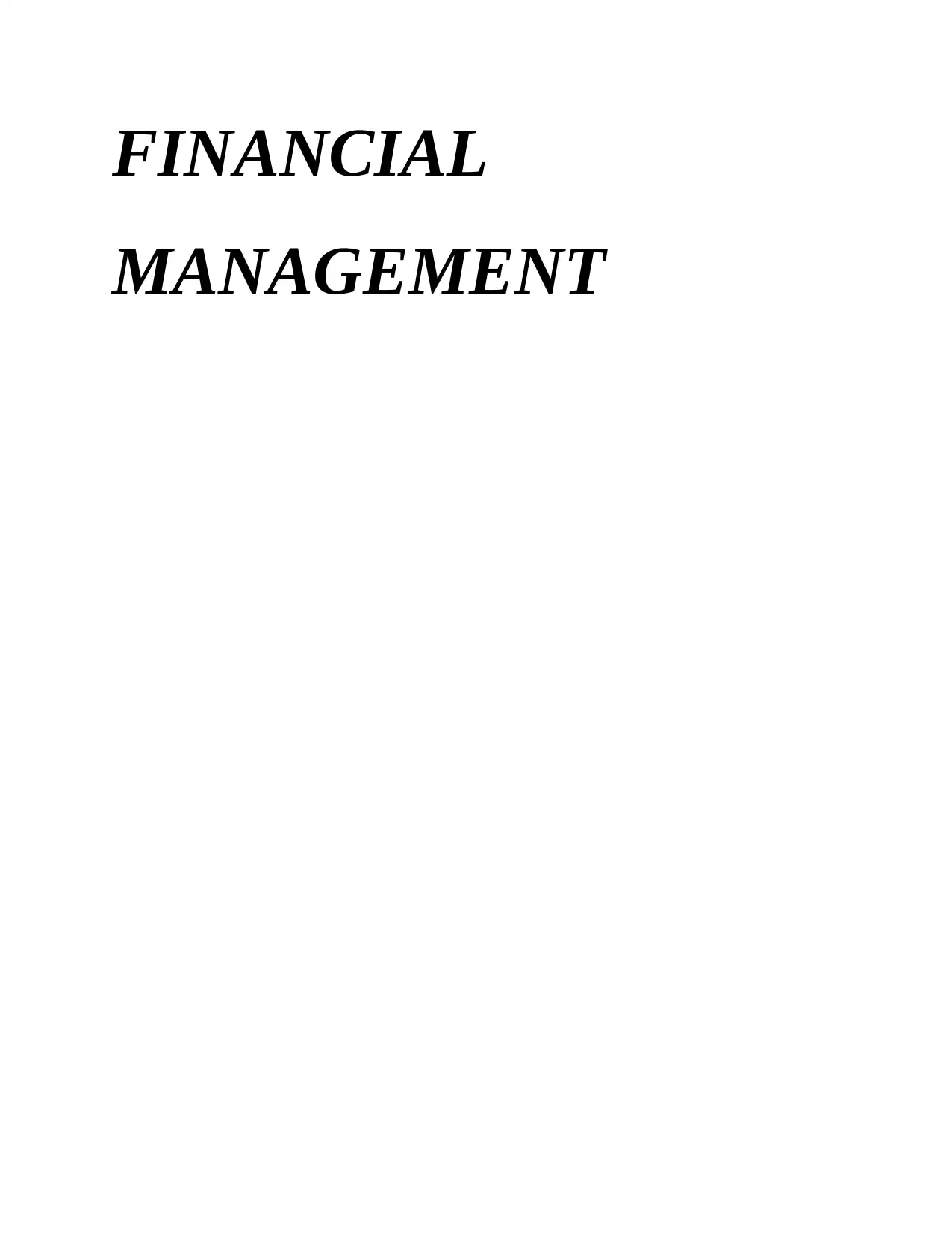
FINANCIAL
MANAGEMENT
MANAGEMENT
Paraphrase This Document
Need a fresh take? Get an instant paraphrase of this document with our AI Paraphraser
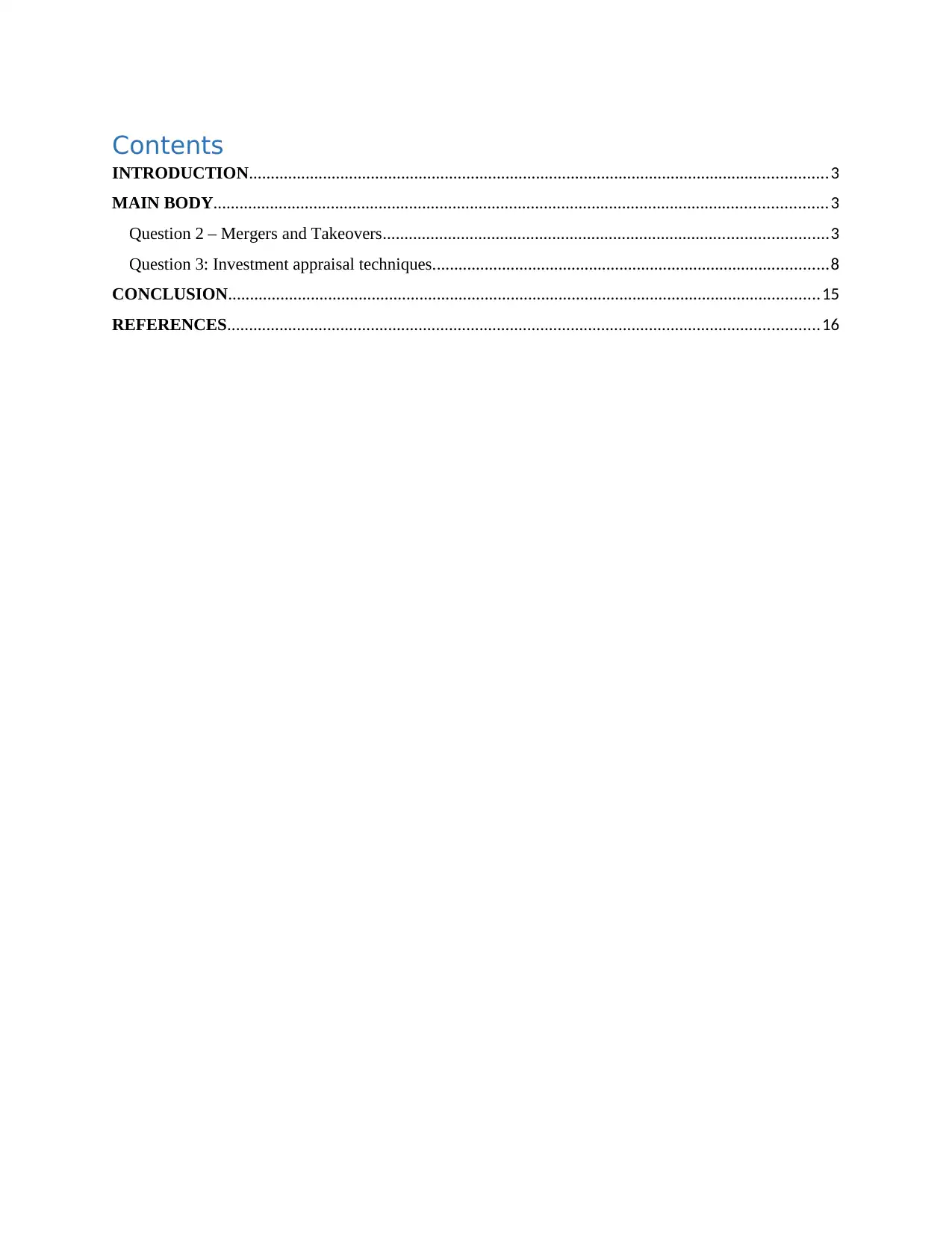
Contents
INTRODUCTION.....................................................................................................................................3
MAIN BODY.............................................................................................................................................3
Question 2 – Mergers and Takeovers......................................................................................................3
Question 3: Investment appraisal techniques...........................................................................................8
CONCLUSION........................................................................................................................................15
REFERENCES........................................................................................................................................16
INTRODUCTION.....................................................................................................................................3
MAIN BODY.............................................................................................................................................3
Question 2 – Mergers and Takeovers......................................................................................................3
Question 3: Investment appraisal techniques...........................................................................................8
CONCLUSION........................................................................................................................................15
REFERENCES........................................................................................................................................16
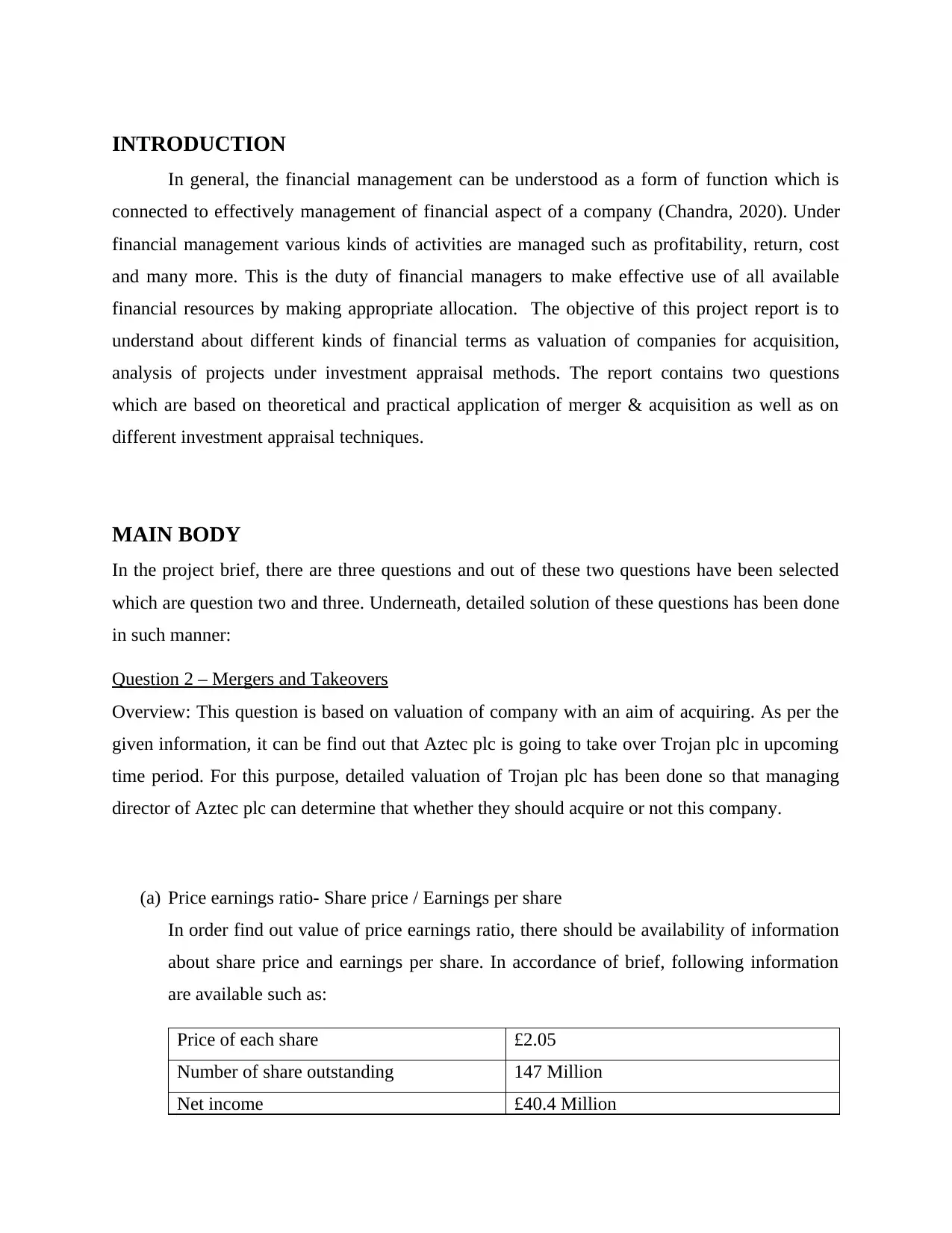
INTRODUCTION
In general, the financial management can be understood as a form of function which is
connected to effectively management of financial aspect of a company (Chandra, 2020). Under
financial management various kinds of activities are managed such as profitability, return, cost
and many more. This is the duty of financial managers to make effective use of all available
financial resources by making appropriate allocation. The objective of this project report is to
understand about different kinds of financial terms as valuation of companies for acquisition,
analysis of projects under investment appraisal methods. The report contains two questions
which are based on theoretical and practical application of merger & acquisition as well as on
different investment appraisal techniques.
MAIN BODY
In the project brief, there are three questions and out of these two questions have been selected
which are question two and three. Underneath, detailed solution of these questions has been done
in such manner:
Question 2 – Mergers and Takeovers
Overview: This question is based on valuation of company with an aim of acquiring. As per the
given information, it can be find out that Aztec plc is going to take over Trojan plc in upcoming
time period. For this purpose, detailed valuation of Trojan plc has been done so that managing
director of Aztec plc can determine that whether they should acquire or not this company.
(a) Price earnings ratio- Share price / Earnings per share
In order find out value of price earnings ratio, there should be availability of information
about share price and earnings per share. In accordance of brief, following information
are available such as:
Price of each share £2.05
Number of share outstanding 147 Million
Net income £40.4 Million
In general, the financial management can be understood as a form of function which is
connected to effectively management of financial aspect of a company (Chandra, 2020). Under
financial management various kinds of activities are managed such as profitability, return, cost
and many more. This is the duty of financial managers to make effective use of all available
financial resources by making appropriate allocation. The objective of this project report is to
understand about different kinds of financial terms as valuation of companies for acquisition,
analysis of projects under investment appraisal methods. The report contains two questions
which are based on theoretical and practical application of merger & acquisition as well as on
different investment appraisal techniques.
MAIN BODY
In the project brief, there are three questions and out of these two questions have been selected
which are question two and three. Underneath, detailed solution of these questions has been done
in such manner:
Question 2 – Mergers and Takeovers
Overview: This question is based on valuation of company with an aim of acquiring. As per the
given information, it can be find out that Aztec plc is going to take over Trojan plc in upcoming
time period. For this purpose, detailed valuation of Trojan plc has been done so that managing
director of Aztec plc can determine that whether they should acquire or not this company.
(a) Price earnings ratio- Share price / Earnings per share
In order find out value of price earnings ratio, there should be availability of information
about share price and earnings per share. In accordance of brief, following information
are available such as:
Price of each share £2.05
Number of share outstanding 147 Million
Net income £40.4 Million
⊘ This is a preview!⊘
Do you want full access?
Subscribe today to unlock all pages.

Trusted by 1+ million students worldwide
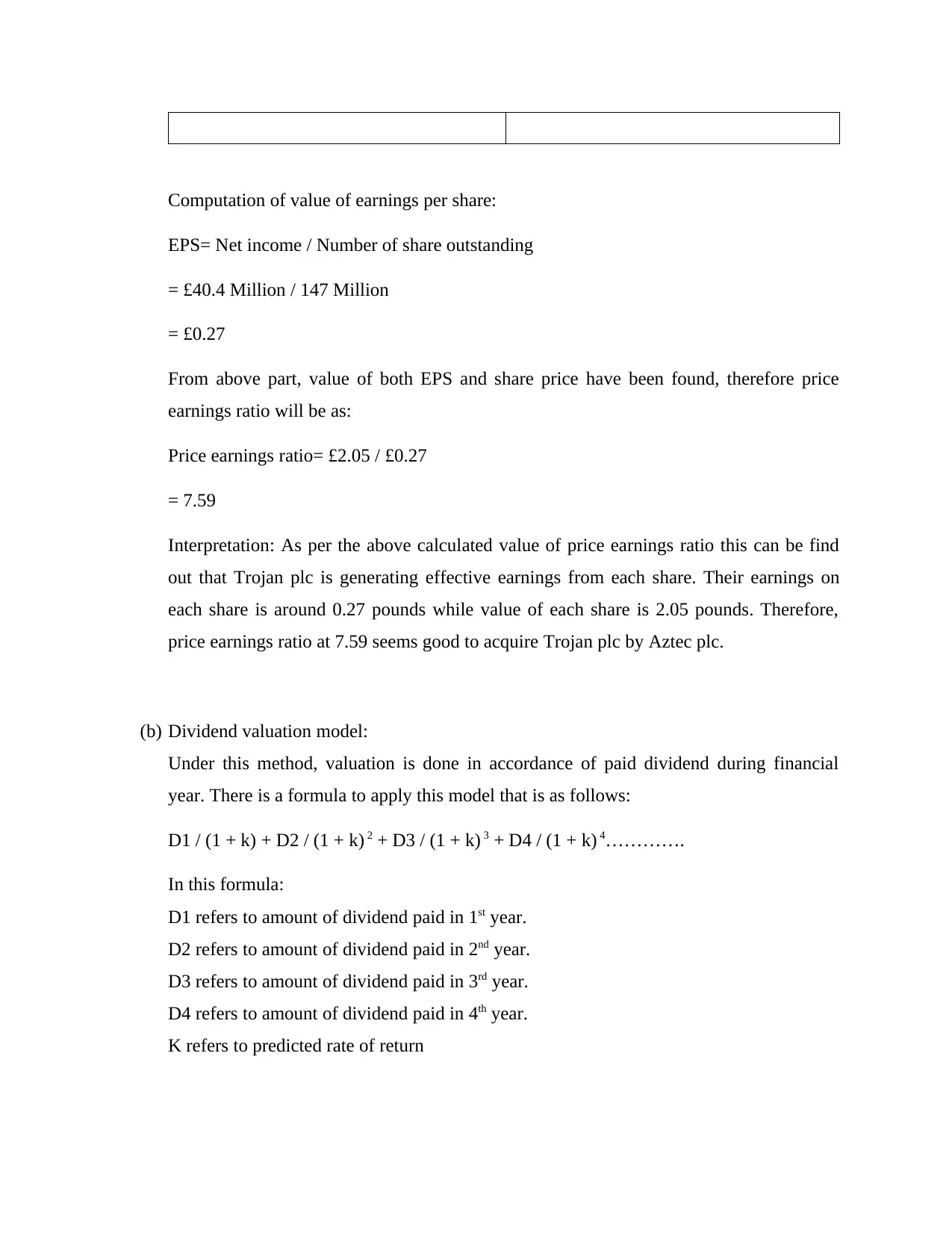
Computation of value of earnings per share:
EPS= Net income / Number of share outstanding
= £40.4 Million / 147 Million
= £0.27
From above part, value of both EPS and share price have been found, therefore price
earnings ratio will be as:
Price earnings ratio= £2.05 / £0.27
= 7.59
Interpretation: As per the above calculated value of price earnings ratio this can be find
out that Trojan plc is generating effective earnings from each share. Their earnings on
each share is around 0.27 pounds while value of each share is 2.05 pounds. Therefore,
price earnings ratio at 7.59 seems good to acquire Trojan plc by Aztec plc.
(b) Dividend valuation model:
Under this method, valuation is done in accordance of paid dividend during financial
year. There is a formula to apply this model that is as follows:
D1 / (1 + k) + D2 / (1 + k) 2 + D3 / (1 + k) 3 + D4 / (1 + k) 4………….
In this formula:
D1 refers to amount of dividend paid in 1st year.
D2 refers to amount of dividend paid in 2nd year.
D3 refers to amount of dividend paid in 3rd year.
D4 refers to amount of dividend paid in 4th year.
K refers to predicted rate of return
EPS= Net income / Number of share outstanding
= £40.4 Million / 147 Million
= £0.27
From above part, value of both EPS and share price have been found, therefore price
earnings ratio will be as:
Price earnings ratio= £2.05 / £0.27
= 7.59
Interpretation: As per the above calculated value of price earnings ratio this can be find
out that Trojan plc is generating effective earnings from each share. Their earnings on
each share is around 0.27 pounds while value of each share is 2.05 pounds. Therefore,
price earnings ratio at 7.59 seems good to acquire Trojan plc by Aztec plc.
(b) Dividend valuation model:
Under this method, valuation is done in accordance of paid dividend during financial
year. There is a formula to apply this model that is as follows:
D1 / (1 + k) + D2 / (1 + k) 2 + D3 / (1 + k) 3 + D4 / (1 + k) 4………….
In this formula:
D1 refers to amount of dividend paid in 1st year.
D2 refers to amount of dividend paid in 2nd year.
D3 refers to amount of dividend paid in 3rd year.
D4 refers to amount of dividend paid in 4th year.
K refers to predicted rate of return
Paraphrase This Document
Need a fresh take? Get an instant paraphrase of this document with our AI Paraphraser
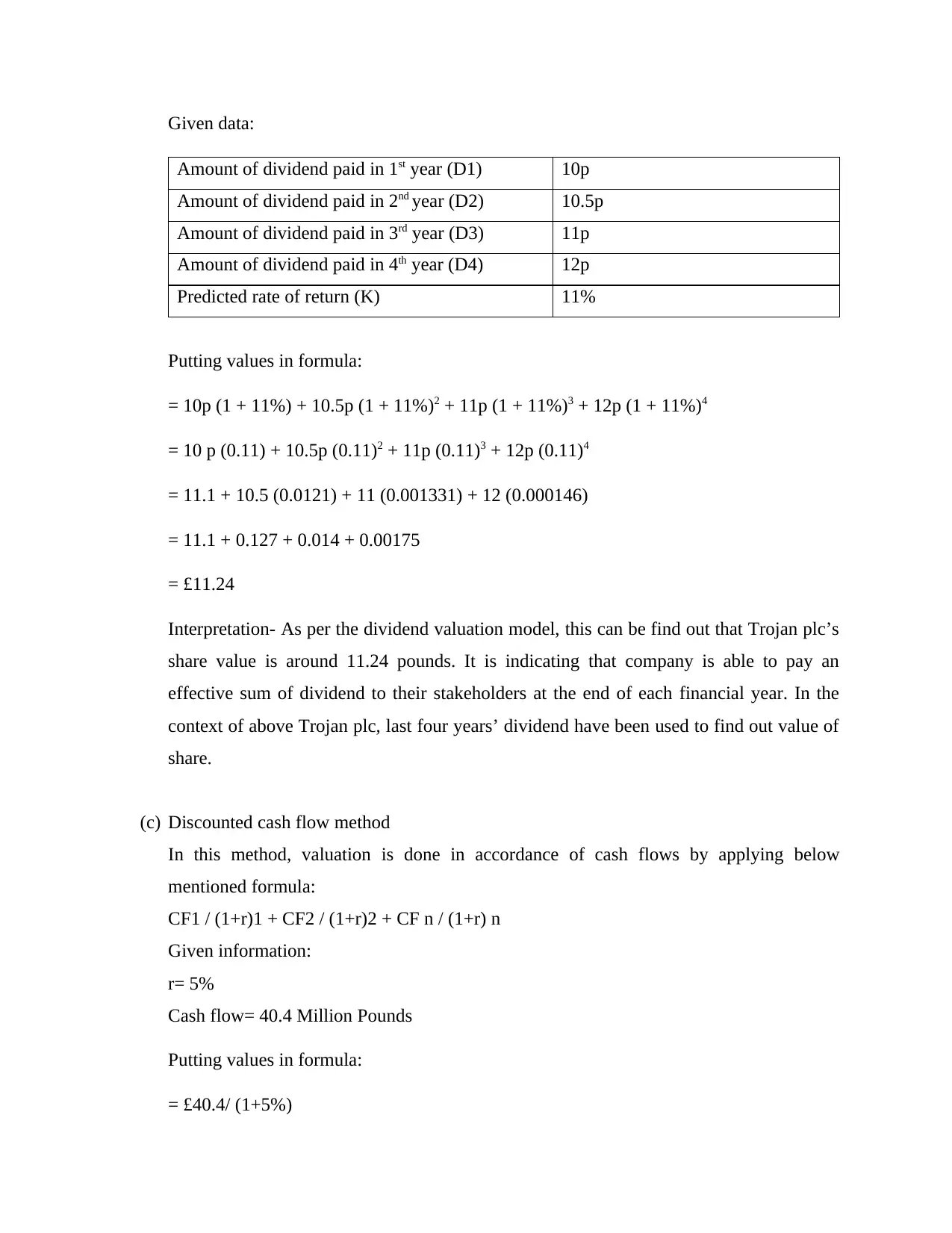
Given data:
Amount of dividend paid in 1st year (D1) 10p
Amount of dividend paid in 2nd year (D2) 10.5p
Amount of dividend paid in 3rd year (D3) 11p
Amount of dividend paid in 4th year (D4) 12p
Predicted rate of return (K) 11%
Putting values in formula:
= 10p (1 + 11%) + 10.5p (1 + 11%)2 + 11p (1 + 11%)3 + 12p (1 + 11%)4
= 10 p (0.11) + 10.5p (0.11)2 + 11p (0.11)3 + 12p (0.11)4
= 11.1 + 10.5 (0.0121) + 11 (0.001331) + 12 (0.000146)
= 11.1 + 0.127 + 0.014 + 0.00175
= £11.24
Interpretation- As per the dividend valuation model, this can be find out that Trojan plc’s
share value is around 11.24 pounds. It is indicating that company is able to pay an
effective sum of dividend to their stakeholders at the end of each financial year. In the
context of above Trojan plc, last four years’ dividend have been used to find out value of
share.
(c) Discounted cash flow method
In this method, valuation is done in accordance of cash flows by applying below
mentioned formula:
CF1 / (1+r)1 + CF2 / (1+r)2 + CF n / (1+r) n
Given information:
r= 5%
Cash flow= 40.4 Million Pounds
Putting values in formula:
= £40.4/ (1+5%)
Amount of dividend paid in 1st year (D1) 10p
Amount of dividend paid in 2nd year (D2) 10.5p
Amount of dividend paid in 3rd year (D3) 11p
Amount of dividend paid in 4th year (D4) 12p
Predicted rate of return (K) 11%
Putting values in formula:
= 10p (1 + 11%) + 10.5p (1 + 11%)2 + 11p (1 + 11%)3 + 12p (1 + 11%)4
= 10 p (0.11) + 10.5p (0.11)2 + 11p (0.11)3 + 12p (0.11)4
= 11.1 + 10.5 (0.0121) + 11 (0.001331) + 12 (0.000146)
= 11.1 + 0.127 + 0.014 + 0.00175
= £11.24
Interpretation- As per the dividend valuation model, this can be find out that Trojan plc’s
share value is around 11.24 pounds. It is indicating that company is able to pay an
effective sum of dividend to their stakeholders at the end of each financial year. In the
context of above Trojan plc, last four years’ dividend have been used to find out value of
share.
(c) Discounted cash flow method
In this method, valuation is done in accordance of cash flows by applying below
mentioned formula:
CF1 / (1+r)1 + CF2 / (1+r)2 + CF n / (1+r) n
Given information:
r= 5%
Cash flow= 40.4 Million Pounds
Putting values in formula:
= £40.4/ (1+5%)

= £808
Interpretation: In accordance of above calculated value of share price under DCF method
this can be stated that Trojan plc is generating effective earnings. This value of share is
computed in accordance of cash flow for year one and cost of capital at 5%.
(d) Analysis of problems associated with above mentioned valuation methods.
Price earnings ratio: It can be defined as a type of ratio which is associated with stating
relation between price of share and earnings on share of a company (Itemgenova and
Sikveland, 2020). This type of ratio is crucial for companies in order to do effective valuation
of a company in term of stock price. Basically, under it study of stock is done with an aim of
identifying measuring stock price of company. In the context of stakeholders and investors,
this ratio is useful as they can do comparison of current market value of company with
earnings. Using this ratio may lead to so issues or drawbacks which are explained below in
such manner-
Drawbacks:
The main issue of using this ratio is that under it structure of debt/ finance is
completely neglected which lead to ineffective valuation.
By using this ratio, users cannot get information about earnings per share growth
of company. As a consequence, investors do not find it useful to take decision for
making investment.
In addition to this, it cannot be implemented in those companies which are
fronting the financial loss (Freihat and Razaq, 2019). The reason behind this issue
is that price earnings ratio fail to determine amount of loss during starting time
period of growth.
Lastly, the anticipation of investors may become cause of inflated prices of stock
for entire sector. The reason behind this is that at the time of recession, share
value can be under evaluated in relation to PE ratio. While at the time of inflation,
earnings of businesses can be assessed as per the value of currency of any specific
country. As a consequence, value of price earnings ratio can be higher.
Interpretation: In accordance of above calculated value of share price under DCF method
this can be stated that Trojan plc is generating effective earnings. This value of share is
computed in accordance of cash flow for year one and cost of capital at 5%.
(d) Analysis of problems associated with above mentioned valuation methods.
Price earnings ratio: It can be defined as a type of ratio which is associated with stating
relation between price of share and earnings on share of a company (Itemgenova and
Sikveland, 2020). This type of ratio is crucial for companies in order to do effective valuation
of a company in term of stock price. Basically, under it study of stock is done with an aim of
identifying measuring stock price of company. In the context of stakeholders and investors,
this ratio is useful as they can do comparison of current market value of company with
earnings. Using this ratio may lead to so issues or drawbacks which are explained below in
such manner-
Drawbacks:
The main issue of using this ratio is that under it structure of debt/ finance is
completely neglected which lead to ineffective valuation.
By using this ratio, users cannot get information about earnings per share growth
of company. As a consequence, investors do not find it useful to take decision for
making investment.
In addition to this, it cannot be implemented in those companies which are
fronting the financial loss (Freihat and Razaq, 2019). The reason behind this issue
is that price earnings ratio fail to determine amount of loss during starting time
period of growth.
Lastly, the anticipation of investors may become cause of inflated prices of stock
for entire sector. The reason behind this is that at the time of recession, share
value can be under evaluated in relation to PE ratio. While at the time of inflation,
earnings of businesses can be assessed as per the value of currency of any specific
country. As a consequence, value of price earnings ratio can be higher.
⊘ This is a preview!⊘
Do you want full access?
Subscribe today to unlock all pages.

Trusted by 1+ million students worldwide
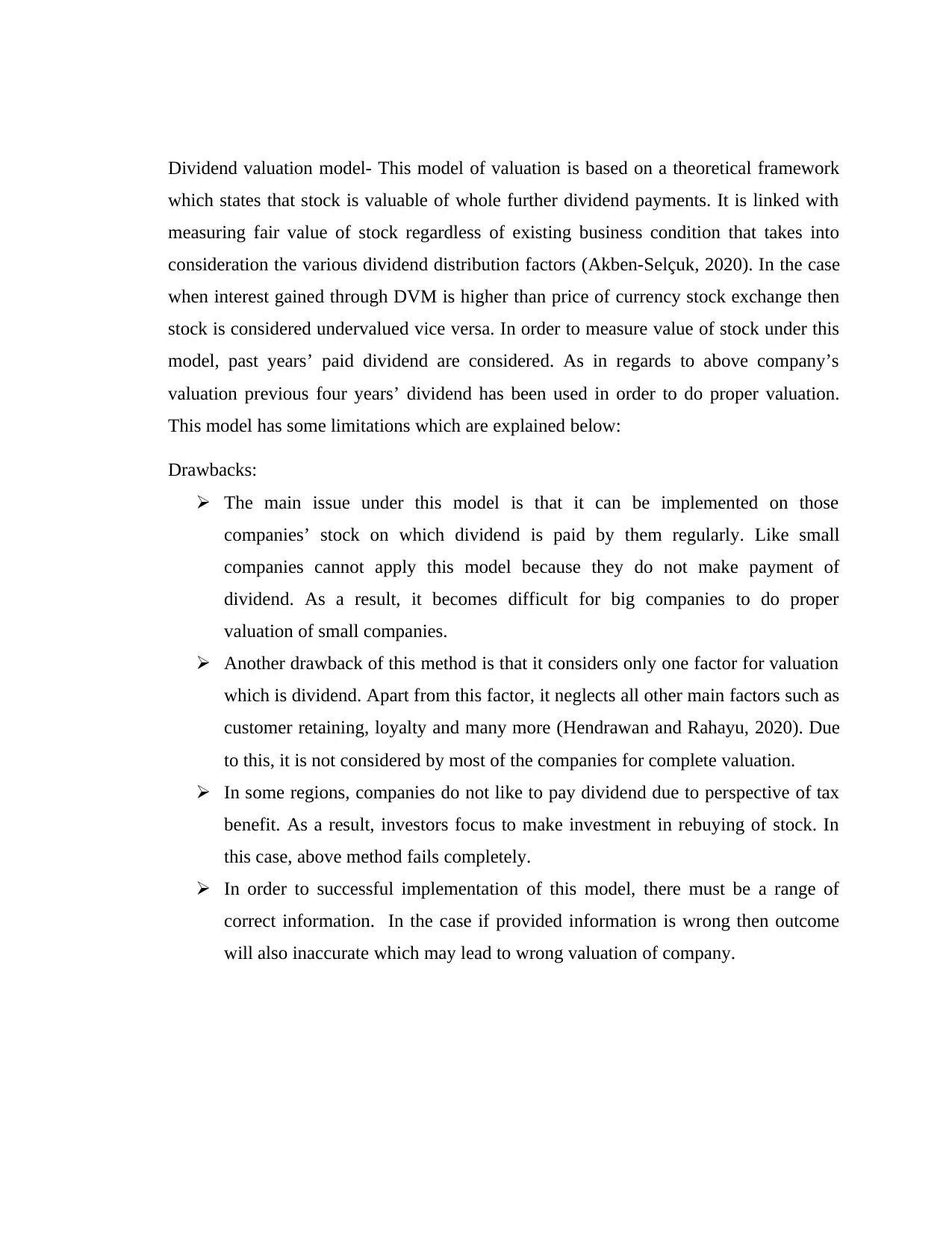
Dividend valuation model- This model of valuation is based on a theoretical framework
which states that stock is valuable of whole further dividend payments. It is linked with
measuring fair value of stock regardless of existing business condition that takes into
consideration the various dividend distribution factors (Akben-Selçuk, 2020). In the case
when interest gained through DVM is higher than price of currency stock exchange then
stock is considered undervalued vice versa. In order to measure value of stock under this
model, past years’ paid dividend are considered. As in regards to above company’s
valuation previous four years’ dividend has been used in order to do proper valuation.
This model has some limitations which are explained below:
Drawbacks:
The main issue under this model is that it can be implemented on those
companies’ stock on which dividend is paid by them regularly. Like small
companies cannot apply this model because they do not make payment of
dividend. As a result, it becomes difficult for big companies to do proper
valuation of small companies.
Another drawback of this method is that it considers only one factor for valuation
which is dividend. Apart from this factor, it neglects all other main factors such as
customer retaining, loyalty and many more (Hendrawan and Rahayu, 2020). Due
to this, it is not considered by most of the companies for complete valuation.
In some regions, companies do not like to pay dividend due to perspective of tax
benefit. As a result, investors focus to make investment in rebuying of stock. In
this case, above method fails completely.
In order to successful implementation of this model, there must be a range of
correct information. In the case if provided information is wrong then outcome
will also inaccurate which may lead to wrong valuation of company.
which states that stock is valuable of whole further dividend payments. It is linked with
measuring fair value of stock regardless of existing business condition that takes into
consideration the various dividend distribution factors (Akben-Selçuk, 2020). In the case
when interest gained through DVM is higher than price of currency stock exchange then
stock is considered undervalued vice versa. In order to measure value of stock under this
model, past years’ paid dividend are considered. As in regards to above company’s
valuation previous four years’ dividend has been used in order to do proper valuation.
This model has some limitations which are explained below:
Drawbacks:
The main issue under this model is that it can be implemented on those
companies’ stock on which dividend is paid by them regularly. Like small
companies cannot apply this model because they do not make payment of
dividend. As a result, it becomes difficult for big companies to do proper
valuation of small companies.
Another drawback of this method is that it considers only one factor for valuation
which is dividend. Apart from this factor, it neglects all other main factors such as
customer retaining, loyalty and many more (Hendrawan and Rahayu, 2020). Due
to this, it is not considered by most of the companies for complete valuation.
In some regions, companies do not like to pay dividend due to perspective of tax
benefit. As a result, investors focus to make investment in rebuying of stock. In
this case, above method fails completely.
In order to successful implementation of this model, there must be a range of
correct information. In the case if provided information is wrong then outcome
will also inaccurate which may lead to wrong valuation of company.
Paraphrase This Document
Need a fresh take? Get an instant paraphrase of this document with our AI Paraphraser
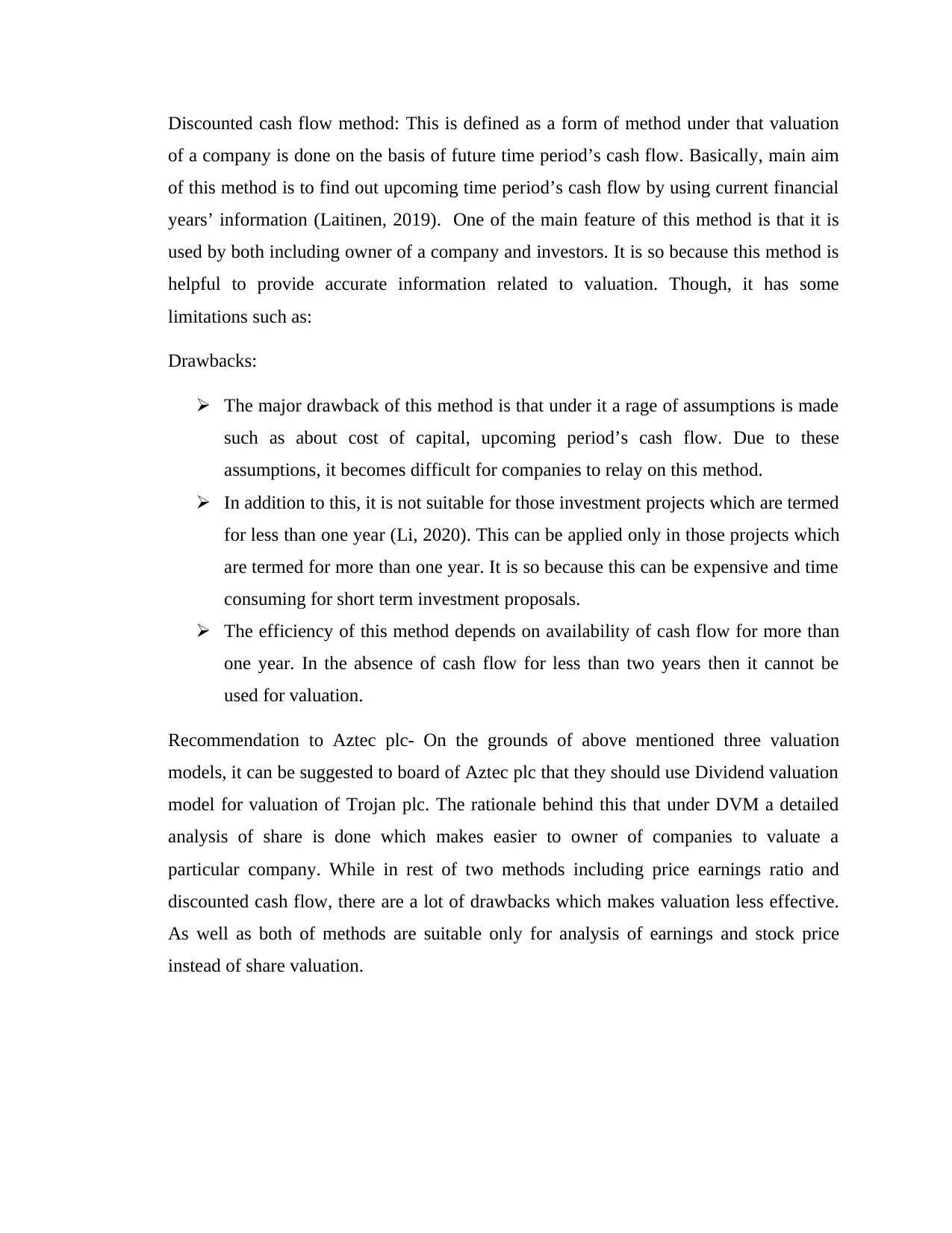
Discounted cash flow method: This is defined as a form of method under that valuation
of a company is done on the basis of future time period’s cash flow. Basically, main aim
of this method is to find out upcoming time period’s cash flow by using current financial
years’ information (Laitinen, 2019). One of the main feature of this method is that it is
used by both including owner of a company and investors. It is so because this method is
helpful to provide accurate information related to valuation. Though, it has some
limitations such as:
Drawbacks:
The major drawback of this method is that under it a rage of assumptions is made
such as about cost of capital, upcoming period’s cash flow. Due to these
assumptions, it becomes difficult for companies to relay on this method.
In addition to this, it is not suitable for those investment projects which are termed
for less than one year (Li, 2020). This can be applied only in those projects which
are termed for more than one year. It is so because this can be expensive and time
consuming for short term investment proposals.
The efficiency of this method depends on availability of cash flow for more than
one year. In the absence of cash flow for less than two years then it cannot be
used for valuation.
Recommendation to Aztec plc- On the grounds of above mentioned three valuation
models, it can be suggested to board of Aztec plc that they should use Dividend valuation
model for valuation of Trojan plc. The rationale behind this that under DVM a detailed
analysis of share is done which makes easier to owner of companies to valuate a
particular company. While in rest of two methods including price earnings ratio and
discounted cash flow, there are a lot of drawbacks which makes valuation less effective.
As well as both of methods are suitable only for analysis of earnings and stock price
instead of share valuation.
of a company is done on the basis of future time period’s cash flow. Basically, main aim
of this method is to find out upcoming time period’s cash flow by using current financial
years’ information (Laitinen, 2019). One of the main feature of this method is that it is
used by both including owner of a company and investors. It is so because this method is
helpful to provide accurate information related to valuation. Though, it has some
limitations such as:
Drawbacks:
The major drawback of this method is that under it a rage of assumptions is made
such as about cost of capital, upcoming period’s cash flow. Due to these
assumptions, it becomes difficult for companies to relay on this method.
In addition to this, it is not suitable for those investment projects which are termed
for less than one year (Li, 2020). This can be applied only in those projects which
are termed for more than one year. It is so because this can be expensive and time
consuming for short term investment proposals.
The efficiency of this method depends on availability of cash flow for more than
one year. In the absence of cash flow for less than two years then it cannot be
used for valuation.
Recommendation to Aztec plc- On the grounds of above mentioned three valuation
models, it can be suggested to board of Aztec plc that they should use Dividend valuation
model for valuation of Trojan plc. The rationale behind this that under DVM a detailed
analysis of share is done which makes easier to owner of companies to valuate a
particular company. While in rest of two methods including price earnings ratio and
discounted cash flow, there are a lot of drawbacks which makes valuation less effective.
As well as both of methods are suitable only for analysis of earnings and stock price
instead of share valuation.
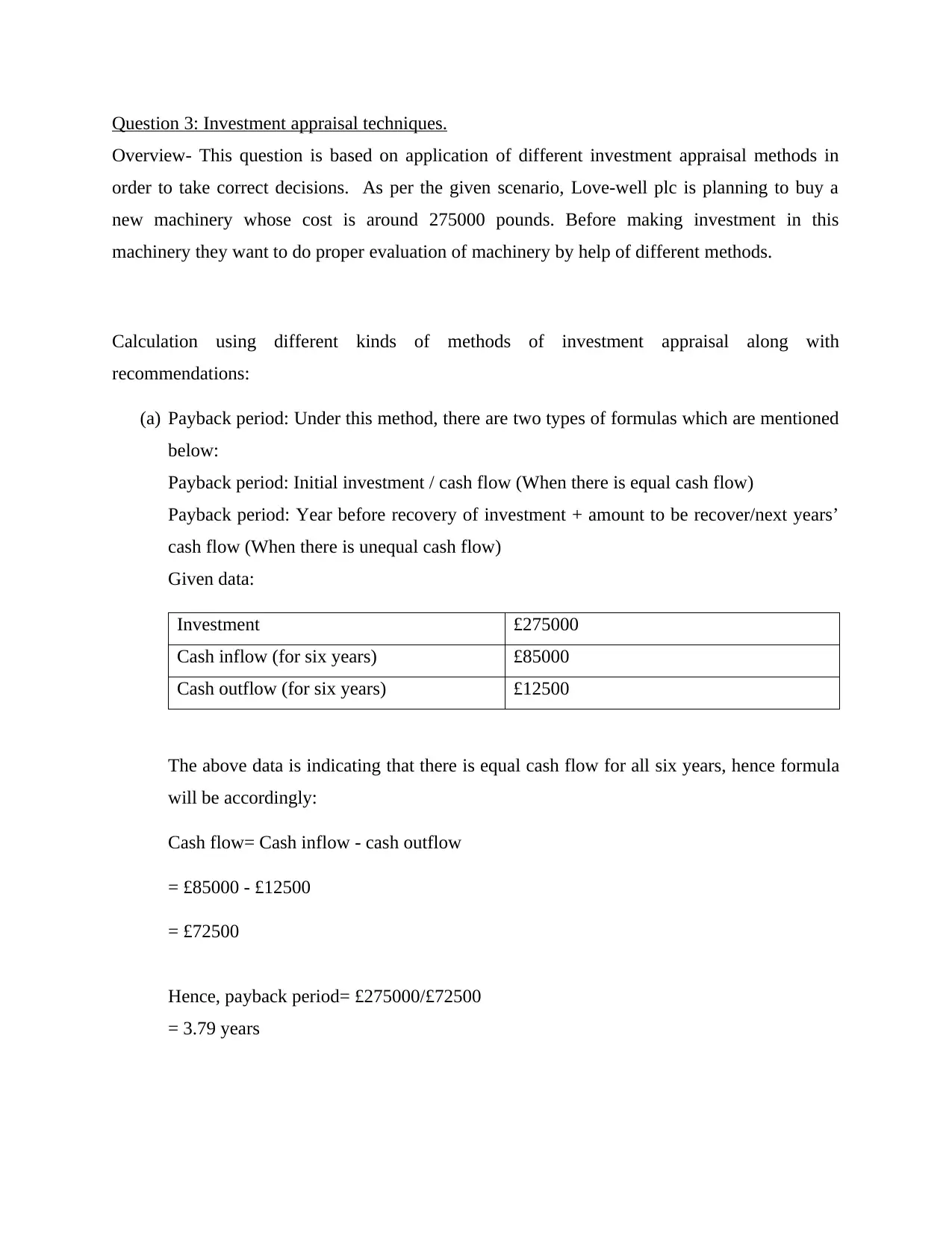
Question 3: Investment appraisal techniques.
Overview- This question is based on application of different investment appraisal methods in
order to take correct decisions. As per the given scenario, Love-well plc is planning to buy a
new machinery whose cost is around 275000 pounds. Before making investment in this
machinery they want to do proper evaluation of machinery by help of different methods.
Calculation using different kinds of methods of investment appraisal along with
recommendations:
(a) Payback period: Under this method, there are two types of formulas which are mentioned
below:
Payback period: Initial investment / cash flow (When there is equal cash flow)
Payback period: Year before recovery of investment + amount to be recover/next years’
cash flow (When there is unequal cash flow)
Given data:
Investment £275000
Cash inflow (for six years) £85000
Cash outflow (for six years) £12500
The above data is indicating that there is equal cash flow for all six years, hence formula
will be accordingly:
Cash flow= Cash inflow - cash outflow
= £85000 - £12500
= £72500
Hence, payback period= £275000/£72500
= 3.79 years
Overview- This question is based on application of different investment appraisal methods in
order to take correct decisions. As per the given scenario, Love-well plc is planning to buy a
new machinery whose cost is around 275000 pounds. Before making investment in this
machinery they want to do proper evaluation of machinery by help of different methods.
Calculation using different kinds of methods of investment appraisal along with
recommendations:
(a) Payback period: Under this method, there are two types of formulas which are mentioned
below:
Payback period: Initial investment / cash flow (When there is equal cash flow)
Payback period: Year before recovery of investment + amount to be recover/next years’
cash flow (When there is unequal cash flow)
Given data:
Investment £275000
Cash inflow (for six years) £85000
Cash outflow (for six years) £12500
The above data is indicating that there is equal cash flow for all six years, hence formula
will be accordingly:
Cash flow= Cash inflow - cash outflow
= £85000 - £12500
= £72500
Hence, payback period= £275000/£72500
= 3.79 years
⊘ This is a preview!⊘
Do you want full access?
Subscribe today to unlock all pages.

Trusted by 1+ million students worldwide

Recommendation: In accordance of above done calculation, this can be find out that cost
of new machinery will be recovered in around 3.79 years. The machinery whose life is
around 6 years but its cost will be covered in almost half years of entire life. Hence,
Love-well plc should buy this new machinery in accordance of computed outcome under
payback period.
(b) Accounting rate of return:
Given information-
Step one:
Step two:
Step three:
of new machinery will be recovered in around 3.79 years. The machinery whose life is
around 6 years but its cost will be covered in almost half years of entire life. Hence,
Love-well plc should buy this new machinery in accordance of computed outcome under
payback period.
(b) Accounting rate of return:
Given information-
Step one:
Step two:
Step three:
Paraphrase This Document
Need a fresh take? Get an instant paraphrase of this document with our AI Paraphraser
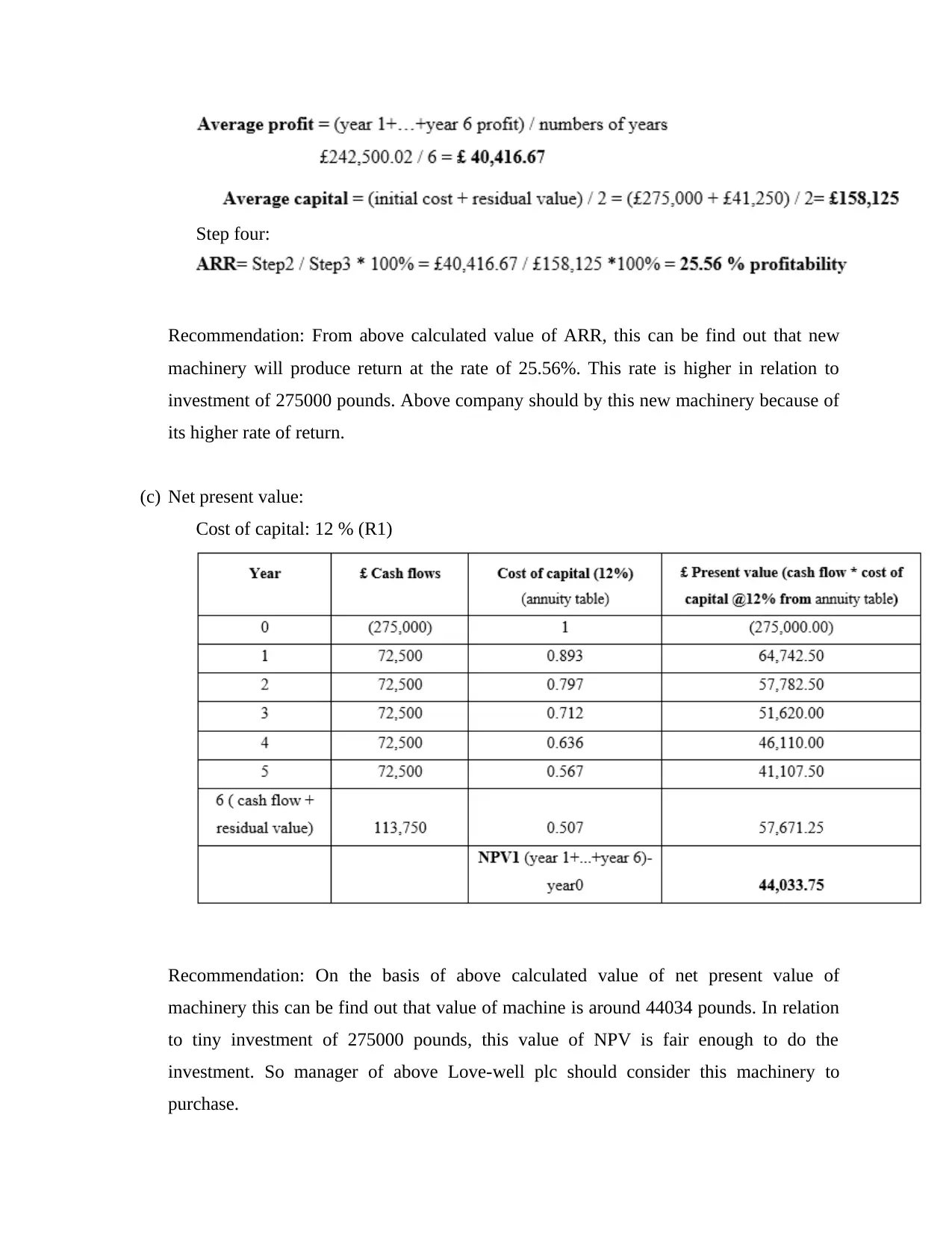
Step four:
Recommendation: From above calculated value of ARR, this can be find out that new
machinery will produce return at the rate of 25.56%. This rate is higher in relation to
investment of 275000 pounds. Above company should by this new machinery because of
its higher rate of return.
(c) Net present value:
Cost of capital: 12 % (R1)
Recommendation: On the basis of above calculated value of net present value of
machinery this can be find out that value of machine is around 44034 pounds. In relation
to tiny investment of 275000 pounds, this value of NPV is fair enough to do the
investment. So manager of above Love-well plc should consider this machinery to
purchase.
Recommendation: From above calculated value of ARR, this can be find out that new
machinery will produce return at the rate of 25.56%. This rate is higher in relation to
investment of 275000 pounds. Above company should by this new machinery because of
its higher rate of return.
(c) Net present value:
Cost of capital: 12 % (R1)
Recommendation: On the basis of above calculated value of net present value of
machinery this can be find out that value of machine is around 44034 pounds. In relation
to tiny investment of 275000 pounds, this value of NPV is fair enough to do the
investment. So manager of above Love-well plc should consider this machinery to
purchase.
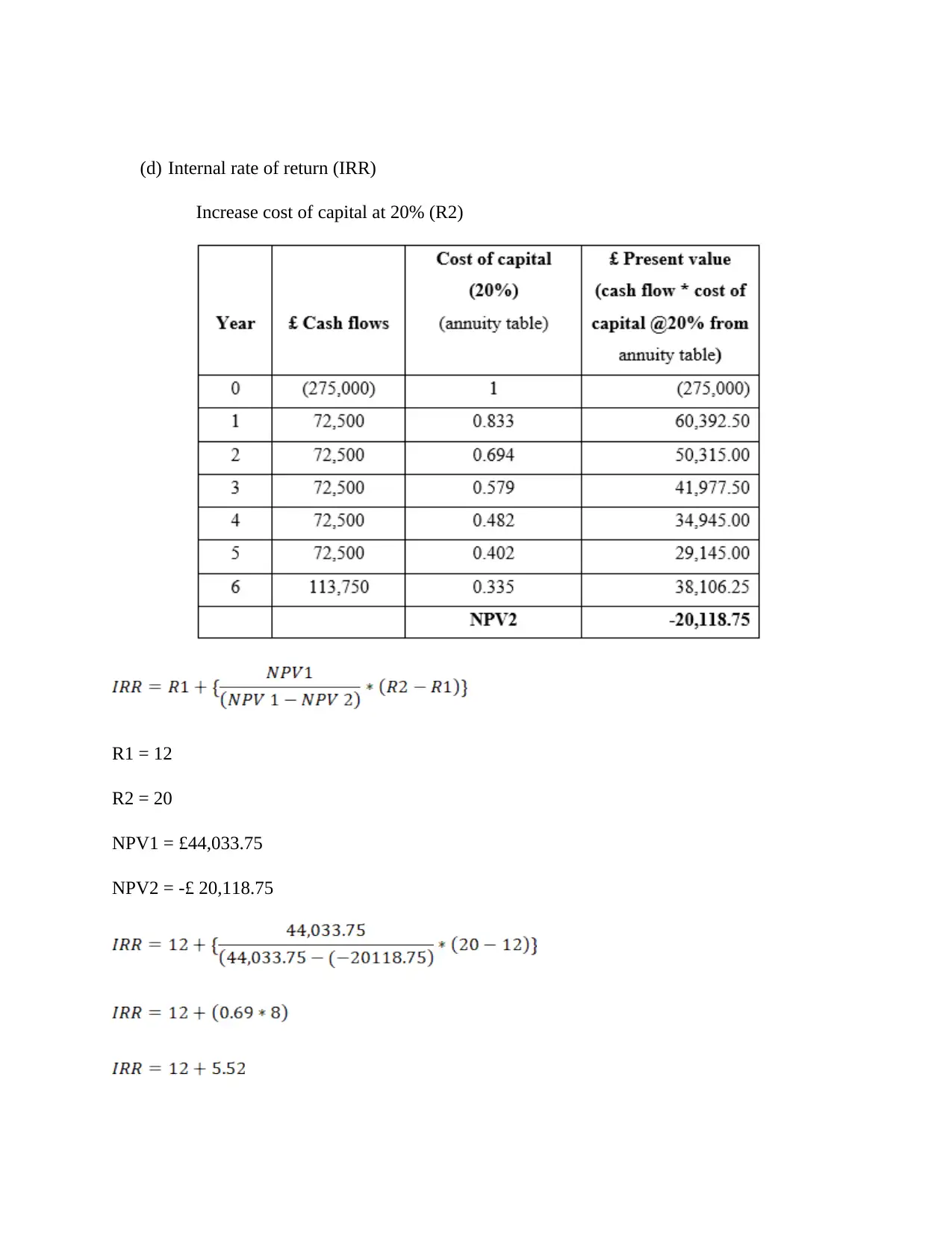
(d) Internal rate of return (IRR)
Increase cost of capital at 20% (R2)
R1 = 12
R2 = 20
NPV1 = £44,033.75
NPV2 = -£ 20,118.75
Increase cost of capital at 20% (R2)
R1 = 12
R2 = 20
NPV1 = £44,033.75
NPV2 = -£ 20,118.75
⊘ This is a preview!⊘
Do you want full access?
Subscribe today to unlock all pages.

Trusted by 1+ million students worldwide
1 out of 17
Related Documents
Your All-in-One AI-Powered Toolkit for Academic Success.
+13062052269
info@desklib.com
Available 24*7 on WhatsApp / Email
![[object Object]](/_next/static/media/star-bottom.7253800d.svg)
Unlock your academic potential
Copyright © 2020–2025 A2Z Services. All Rights Reserved. Developed and managed by ZUCOL.





